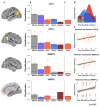Mentalizing regions represent distributed, continuous, and abstract dimensions of others' beliefs
- PMID: 28807871
- PMCID: PMC5696012
- DOI: 10.1016/j.neuroimage.2017.08.026
Mentalizing regions represent distributed, continuous, and abstract dimensions of others' beliefs
Abstract
The human capacity to reason about others' minds includes making causal inferences about intentions, beliefs, values, and goals. Previous fMRI research has suggested that a network of brain regions, including bilateral temporo-parietal junction (TPJ), superior temporal sulcus (STS), and medial prefrontal-cortex (MPFC), are reliably recruited for mental state reasoning. Here, in two fMRI experiments, we investigate the representational content of these regions. Building on existing computational and neural evidence, we hypothesized that social brain regions contain at least two functionally and spatially distinct components: one that represents information related to others' motivations and values, and another that represents information about others' beliefs and knowledge. Using multi-voxel pattern analysis, we find evidence that motivational versus epistemic features are independently represented by theory of mind (ToM) regions: RTPJ contains information about the justification of the belief, bilateral TPJ represents the modality of the source of knowledge, and VMPFC represents the valence of the resulting emotion. These representations are found only in regions implicated in social cognition and predict behavioral responses at the level of single items. We argue that cortical regions implicated in mental state inference contain complementary, but distinct, representations of epistemic and motivational features of others' beliefs, and that, mirroring the processes observed in sensory systems, social stimuli are represented in distinct and distributed formats across the human brain.
Keywords: Multi-voxel pattern analysis (MVPA); Theory of mind; fMRI.
Copyright © 2017 The Authors. Published by Elsevier Inc. All rights reserved.
Figures



References
-
- Amodio DM, Frith CD. Meeting of minds: the medial frontal cortex and social cognition. Nat Rev Neurosci. 2006;7:268–277. http://dx.doi.org/10.1038/nrn1884. - DOI - PubMed
-
- Baker CL, Jara-Ettinger J, Saxe R, Tenenbaum JB. Rational quantitative attribution of beliefs, desires and percepts in human mentalizing. Nat Hum Behav. 2017;1:0064.
-
- Baker CL, Saxe R, Tenenbaum JB. Action understanding as inverse planning. Cognition. 2009;113:329–349. - PubMed
-
- Behrens TEJ, Hunt LT, Woolrich MW, Rushworth MFS. Associative learning of social value. Nature. 2008;456:245–249. http://dx.doi.org/10.1038/nature07538. - DOI - PMC - PubMed
-
- Bello P. Cognitive foundations for a computational theory of mindreading. Adv Cogn Syst. 2012;1
Publication types
MeSH terms
Grants and funding
LinkOut - more resources
Full Text Sources
Other Literature Sources

